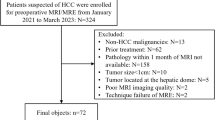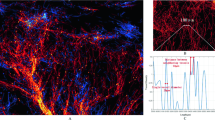Abstract
Objectives
To differentiate between abnormal tumor vessels and regular brain vasculature using new quantitative measures in time-of-flight (TOF) MR angiography (MRA) data.
Materials and methods
In this work time-of-flight (TOF) MR angiography data are acquired in 11 glioma patients to quantify vessel abnormality. Brain vessels are first segmented with a new algorithm, efficient monte-carlo image-analysis for the location of vascular entity (EMILOVE), and are then characterized in three brain regions: tumor, normal-appearing contralateral brain, and the total brain volume without the tumor. For characterization local vessel orientation angles and the dot product between local orientation vectors are calculated and averaged in the 3 regions. Additionally, correlation with histological and genetic markers is performed.
Results
Both the local vessel orientation angles and the dot product show a statistically significant difference (p < 0.005) between tumor vessels and normal brain vasculature. Furthermore, the connection to both histology and the gene expression of the tumor can be found—here, the measures were compared to the proliferation marker Ki-67 [MIB] and genome-wide expression analysis. The results in a subgroup indicate that the dot product measure may be correlated with activated genetic pathways.
Conclusion
It is possible to define a measure of vessel abnormality based on local vessel orientation angles which can differentiate between normal brain vasculature and glioblastoma vessels.








Similar content being viewed by others
References
Wesseling P, Ruiter DJ, Burger PC (1997) Angiogenesis in brain tumors; pathobiological and clinical aspects. J Neurooncol 32:253–265
Norden AD, Drappatz J, Wen PY (2008) Novel anti-angiogenic therapies for malignant gliomas. Lancet Neurol 7:1152–1160
Verhoeff JJ, van Tellingen O, Claes A, Stalpers LJ, van Linde ME, Richel DJ, Leenders WP, van Furth WR (2009) Concerns about anti-angiogenic treatment in patients with glioblastoma multiforme. BMC Cancer 9:444
Emblem KE, Mouridsen K, Bjornerud A, Farrar CT, Jennings D, Borra RJ, Wen PY, Ivy P, Batchelor TT, Rosen BR (2013) Vessel architectural imaging identifies cancer patient responders to anti-angiogenic therapy. Nat Med 19:1178–1183
Giesel FL, Mehndiratta A, Essig M (2010) High-relaxivity contrast-enhanced magnetic resonance neuroimaging: a review. Eur Radiol 20:2461–2474
Lüdemann L, Grieger W, Wurm R, Wust P, Zimmer C (2005) Quantitative measurement of leakage volume and permeability in gliomas, meningiomas and brain metastases with dynamic contrast-enhanced MRI. Magn Reson Imaging 23:833–841
Bock M, Schulz J, Ueltzhoeffer S, Giesel F, Voth M, Essig M (2008) Intravascular contrast agent T1 shortening: fast T1 relaxometry in a carotid volunteer study. Magn Reson Mater Phy Biol Med 21:363–368
Axel L (1984) Blood flow effects in magnetic resonance imaging. Am J Roentgenol 143:1157–1166
Kadota T, Nakagawa H, Kuroda C (1998) Malignant glioma: evaluation with 3D time-of-flight MR angiography. Acta Radiol 39:227–232
Saito R, Kumabe T, Inoue T, Takada S, Yamashita Y, Kanamori M, Sonoda Y, Tominaga T (2009) Magnetic resonance imaging for preoperative identification of the lenticulostriate arteries in insular glioma surgery: technical note. J Neurosurg 111:278–281
Kang C-K, Park C-W, Han J-Y, Kim S-H, Park C-A, Kim K-N, Hong S-M, Kim Y-B, Lee KH, Cho Z-H (2009) Imaging and analysis of lenticulostriate arteries using 7.0-Tesla magnetic resonance angiography. Magn Reson Med 61:136–144
Bullitt E, Gerig G, Pizer SM, Lin W, Aylward SR (2003) Measuring tortuosity of the intracerebral vasculature from MRA images. IEEE Trans Med Imaging 22:1163–1171
Di Ieva A (2010) Angioarchitectural morphometrics of brain tumors: are there any potential histopathological biomarkers? Microvasc Res 80:522–533
Avnir D, Biham O, Lidar D, Malcai O (1998) Is the geometry of nature fractal? Science 279:39–40
Radbruch A, Eidel O, Wiestler B, Paech D, Burth S, Kickingereder P, Nowosielski M, Bäumer P, Wick W, Schlemmer H-P (2014) Quantification of tumor vessels in glioblastoma patients using time-of-flight angiography at 7 Tesla: a feasibility study. PLoS ONE 9:e110727
Frangi AF, Niessen WJ, Vincken KL, Viergever MA (1998) Multiscale vessel enhancement filtering. Med. Image Comput. Comput.-Assist. Interv. Springer, Berlin, pp 130–137
Nägele T, Klose U, Grodd W, Voigt K, Nüsslin F (1995) Nonlinear excitation profiles for three-dimensional inflow MR angiography. J Magn Reson Imaging 5:416–420
Smith SM (2002) Fast robust automated brain extraction. Hum Brain Mapp 17:143–155
Fedorov A, Beichel R, Kalpathy-Cramer J, Finet J, Fillion-Robin J-C, Pujol S, Bauer C, Jennings D, Fennessy F, Sonka M (2012) 3D Slicer as an image computing platform for the Quantitative Imaging Network. Magn Reson Imaging 30:1323–1341
Skibbe H, Reisert M, Maeda S, Koyama M, Oba S, Ito K, Ishii S (2015) Efficient monte carlo image analysis for the location of vascular entity. IEEE Trans Med Imaging 34:628–643
Mootha VK, Lindgren CM, Eriksson K-F, Subramanian A, Sihag S, Lehar J, Puigserver P, Carlsson E, Ridderstråle M, Laurila E, Houstis N, Daly MJ, Patterson N, Mesirov JP, Golub TR, Tamayo P, Spiegelman B, Lander ES, Hirschhorn JN, Altshuler D, Groop LC (2003) PGC-1alpha-responsive genes involved in oxidative phosphorylation are coordinately downregulated in human diabetes. Nat Genet 34:267–273
Subramanian A, Tamayo P, Mootha VK, Mukherjee S, Ebert BL, Gillette MA, Aulovich A, Pomeroy SL, Golub TR, Lander ES, Mesirov JP (2005) Gene set enrichment analysis: a knowledge-based approach for interpreting genome-wide expression profiles. Proc Natl Acad Sci USA 102:15545–15550
Bullitt E, Ewend M, Vredenburgh J, Friedman A, Lin W, Wilber K, Zeng D, Aylward SR, Reardon D (2009) Computerized assessment of vessel morphological changes during treatment of glioblastoma multiforme: report of a case imaged serially by MRA over four years. Neuroimage 47:T143–T151
Sun H, Guo D, Su Y, Yu D, Wang Q, Wang T, Zhou Q, Ran X, Zou Z (2014) Hyperplasia of pericytes is one of the main characteristics of microvascular architecture in malignant glioma. PLoS ONE 9:e114246
Bredel M, Scholtens DM, Yadav AK, Alvarez AA, Renfrow JJ, Chandler JP, Yu ILY, Carro MS, Dai F, Tagge MJ, Ferrarese R, Bredel C, Phillips HS, Lukac PJ, Robe PA, Weyerbrock A, Vogel H, Dubner S, Mobley B, He X, Scheck AC, Sikic BI, Aldape KD, Chakravarti A, Harsh GR (2011) NFKBIA deletion in glioblastomas. N Engl J Med 364:627–637
Lee DW, Ramakrishnan D, Valenta J, Parney IF, Bayless KJ, Sitcheran R (2013) The NF-κB RelB protein is an oncogenic driver of mesenchymal glioma. PLoS One 8:e57489
Raychaudhuri B, Vogelbaum MA (2011) IL-8 is a mediator of NF-κB induced invasion by gliomas. J Neurooncol 101:227–235
Bhat KPL, Balasubramaniyan V, Vaillant B, Ezhilarasan R, Hummelink K, Hollingsworth F, Wani K, Heathcock L, James JD, Goodman LD, Conroy S, Long L, Lelic N, Wang S, Gumin J, Raj D, Kodama Y, Raghunathan A, Olar A, Joshi K, Pelloski CE, Heimberger A, Kim SH, Cahill DP, Rao G, Den Dunnen WFA, Boddeke HWGM, Phillips HS, Nakano I, Lang FF, Colman H, Sulman EP, Aldape K (2013) Mesenchymal differentiation mediated by NF-κB promotes radiation resistance in glioblastoma. Cancer Cell 24:331–346
Kuo H-Y, Hsu H-T, Chen Y-C, Chang Y-W, Liu F-T, Wu C-W (2015) Galectin-3 modulates the EGFR signalling-mediated regulation of Sox2 expression via c-Myc in lung cancer. Glycobiology. doi:10.1093/glycob/cwv088
Gopas J, Ono M, Princler G, Smith MR, Tainsky MA, Siddiqui MA, Wishniak O, Segal S, Kuwano M, Kung HF (1992) EGF receptor activity and mitogenic response of Balb/3T3 cells expressing Ras and Myc oncogenes. EGF receptor activity in oncogene transformed cells. Cell Mol Biol 38:605–614
Eissa AM, Wilman AH (2007) Effects of RF inhomogeneity at 3.0T on ramped RF excitation: application to 3D time-of-flight MR angiography of the intracranial arteries. J Magn Reson Imaging 25:466–472
Acknowledgments
This work was supported in parts by a grant from the Deutsche Forschungsgemeinschaft (DFG) under grant number HA 7006/1-1.
Author information
Authors and Affiliations
Corresponding author
Ethics declarations
Conflict of interest
The authors declare that they have no conflict of interest.
Ethical approval
All procedures performed in studies involving human participants were in accordance with the ethical standards of the institutional and/or national research committee and with the 1964 Helsinki declaration and its later amendments or comparable ethical standards.
Informed consent
Informed consent was obtained from all individual participants included in the study.
Rights and permissions
About this article
Cite this article
Strumia, M., Reichardt, W., Staszewski, O. et al. Glioma vessel abnormality quantification using time-of-flight MR angiography. Magn Reson Mater Phy 29, 765–775 (2016). https://doi.org/10.1007/s10334-016-0558-z
Received:
Revised:
Accepted:
Published:
Issue Date:
DOI: https://doi.org/10.1007/s10334-016-0558-z




